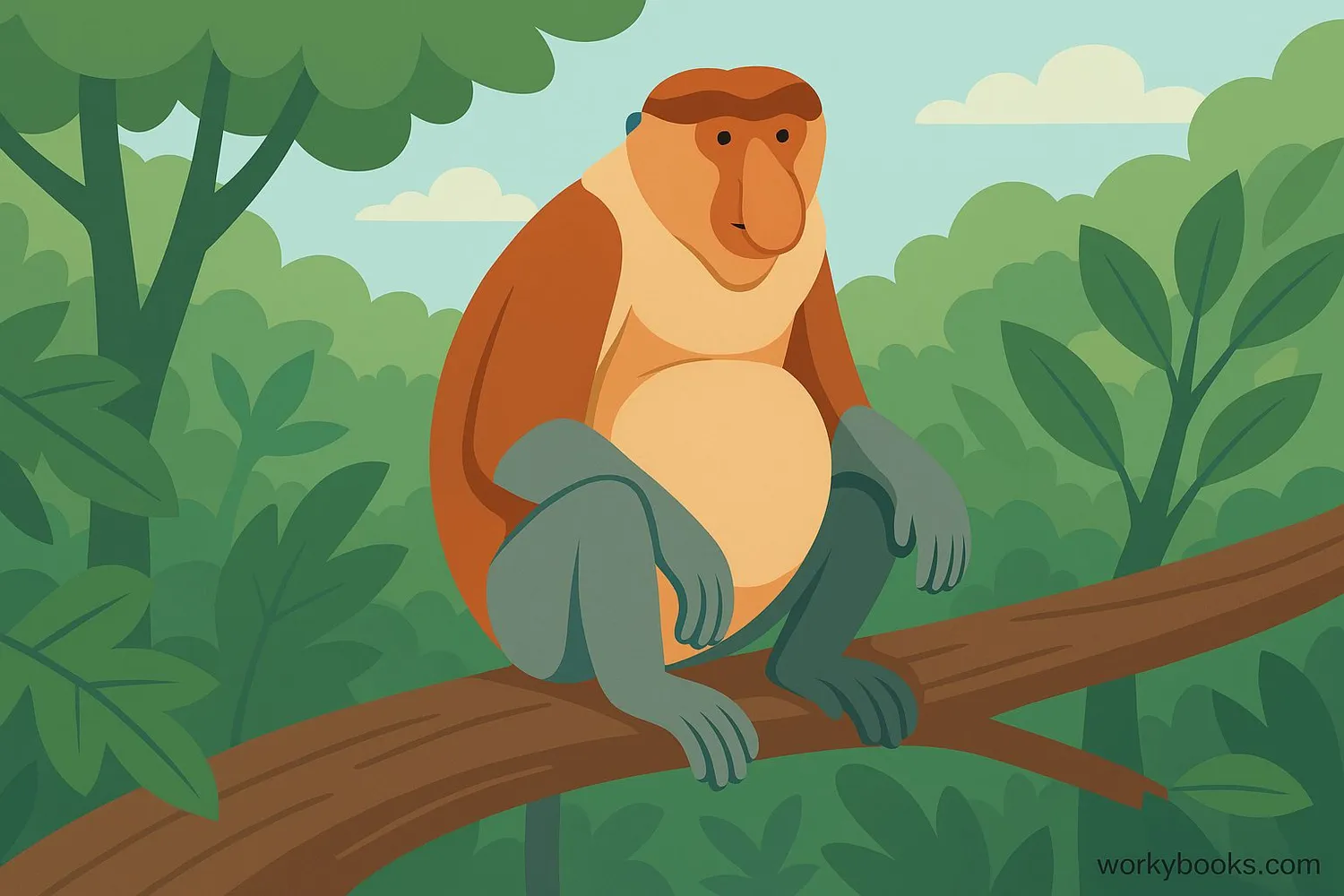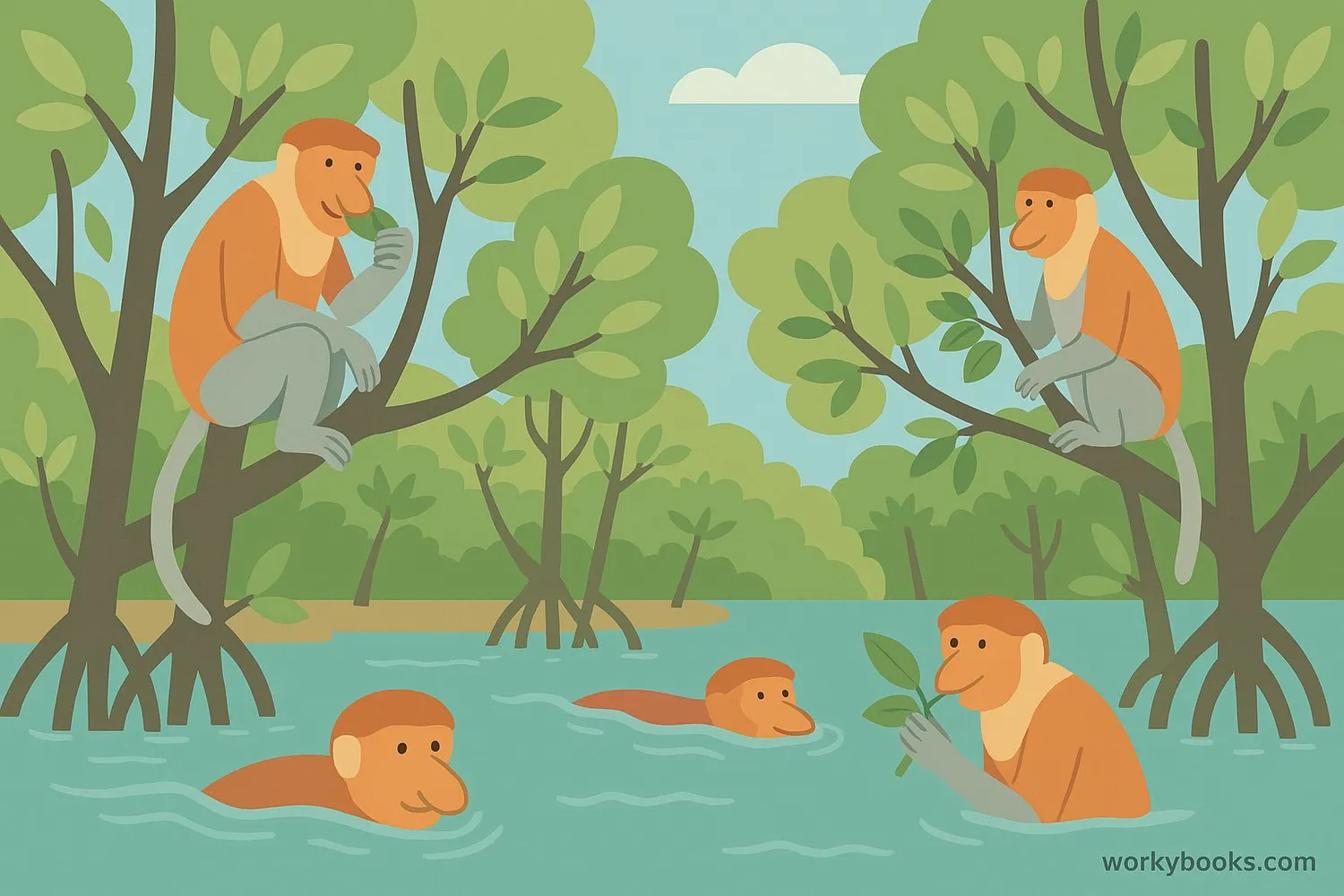Proboscis Monkey - Definition, Examples, Quiz, FAQ, Trivia
Learn about the unique large-nosed monkeys of Borneo
What is a Proboscis Monkey?

The proboscis monkey (scientific name: Nasalis larvatus) is one of the most unusual looking primates in the world. These monkeys are famous for their large, drooping noses - especially the males, whose noses can grow over 4 inches long!
Proboscis monkeys are medium-sized primates that live only on the island of Borneo in Southeast Asia. They have reddish-brown fur on their backs and lighter cream-colored fur on their bellies. Adults typically weigh between 16-24 kg (35-53 lbs) and measure 53-76 cm (21-30 in) long, not including their tails.
Distinctive Nose
Males have large, fleshy noses that hang down over their mouths
Reddish Fur
Reddish-brown back with light cream underside
Pot Belly
Large stomach from their leaf-based diet
Webbed Feet
Partially webbed toes for swimming
Long Tail
Tail nearly as long as their body (50-75 cm)
Did You Know?
The male's large nose acts like a sound chamber, making their warning calls louder to scare away predators and attract females!
Habitat and Behavior

Proboscis monkeys live only on the island of Borneo, which is shared by three countries: Malaysia, Indonesia, and Brunei. They are specially adapted to live in:
• Mangrove forests along rivers and coasts
• Lowland rainforests near water
• Swamp forests with lots of trees
These monkeys are excellent swimmers with partially webbed feet. They can swim across rivers to escape predators or find food, often jumping into the water from heights of 15-20 meters (50-65 feet)!
Diet
Mainly leaves, with some fruits, seeds, and flowers
Social Groups
Live in groups of 10-30 with one dominant male
Swimming
Excellent swimmers with webbed feet
Proboscis monkeys are diurnal (active during the day) and spend most of their time in trees. At night, they sleep in trees near rivers to avoid predators like crocodiles. Their digestive system has special bacteria to help break down tough leaves, which gives them their distinctive pot bellies.
Conservation Status

Proboscis monkeys are endangered according to the International Union for Conservation of Nature (IUCN). Their population has decreased by more than 50% in the last 40 years due to:
• Habitat loss from deforestation for palm oil plantations
• Hunting for food and traditional medicine
• Fragmentation of their forest homes
Conservation efforts are underway to protect these unique primates, including creating protected areas and educating local communities.
Endangered
Population declined by over 50% in 40 years
Habitat Loss
Mangroves cleared for palm oil and development
Protection
Protected in national parks and reserves
How You Can Help
Choose sustainable palm oil products to help protect proboscis monkey habitats. Look for the RSPO (Roundtable on Sustainable Palm Oil) certification.
Proboscis Monkey Quiz
Test your knowledge about proboscis monkeys with this quiz. Answer all 5 questions to see how much you've learned.
Frequently Asked Questions
Here are answers to common questions about proboscis monkeys:
Interesting Facts
Discover some amazing facts about proboscis monkeys:
Swimming Champions
Proboscis monkeys are among the best swimmers of all primates. They can swim up to 20 meters (66 feet) underwater and often cross rivers to find food or escape predators.
Specialized Diet
Their digestive system has special bacteria to break down toxic compounds in leaves. This gives them their pot bellies and makes them one of the few primates that can survive mainly on leaves.
Social Structure
Proboscis monkeys live in harems with one adult male, several females, and their offspring. Young males form bachelor groups until they can establish their own harem.
Cultural Significance
In local folklore, the proboscis monkey is sometimes called "Dutch monkey" because its large nose and pot belly reminded people of Dutch colonists in Borneo.


